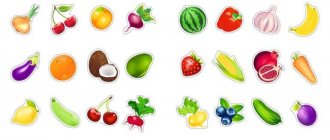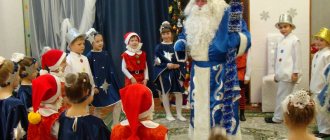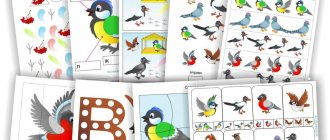A series of educational board games about your hometown
Municipal preschool educational budgetary institution
“General developmental kindergarten No. 25 “Crane”
Arsenyevsky urban district
Board-printed didactic game
“In the city of Arsenyev there is...”
Author: Elena Pavlovna Vetrova, teacher of Children’s Preschool Institution No. 25 “Crane”
Arsenyev
2018
This game can be used in direct educational activities, during interaction between adults and children in restricted moments, and in independent play activities.
Name of the game:
"Loto "My city - Arsenyev"
Children's age
: 4-6 years.
Game task:
it is necessary to select part pictures for the corresponding urban object.
Didactic tasks
:
Expand children's ideas about the city, its enterprises (Arsenyevsky milk, the Cosmos cinema, the Progress cultural palace, which houses the Veselaya Arena circus studio). Continue to cultivate love for your hometown.
Develop cognitive processes: attention, memory, thinking and speech.
Rules of the game
:
1 child can participate in the 1st version of the game. He must lay out all the subject pictures on game cards;
In the 2nd version of the game, 4 children (according to the number of game cards) and the presenter can participate. The teacher may be the leader at the initial stage. Next, the role of the leader can be played by the child. Each player is dealt a game card (4 game cards in total). At the initial stage, the presenter shows a picture, talks about the place depicted on it, or the children themselves guess the place. When playing again, the children themselves name the place and talk about it. The first player to cover his entire card wins.
Progress of the game, organization of children for the game:
1. Option.
Introduction to the game.
The child is asked to look at object pictures that are placed in one pile. The teacher explains that the “Mixed Up” Wizard came and mixed everything up and that all the pictures need to be put in their places.
Option 2.
Introduction to the game.
The teacher invites the children to get acquainted with the new game (4 children participate, the rest can watch the progress of the game). Children look at game cards (fields). The teacher explains the rules of the game to the children. Participants choose a game card as desired. The teacher-leader shows the pictures one at a time. The child who has this object on the card takes the picture for himself and covers the field of the card with it.
When playing again, the role of the leader can be played by the winner or determined using a counting rhyme.
Game clarification:
In the future, game cards (fields) can be supplemented with new cards with new enterprises, that is, thereby expanding the game.
Materials used:
The pictures used in the game were found freely available on the Internet.
Photo of the game “In the city of Arsenyev there is...”
Municipal preschool educational budgetary institution
“General developmental kindergarten No. 25 “Crane”
Arsenyevsky urban district
Board-printed didactic game
"Memory"
Author: Elena Pavlovna Vetrova, teacher of Children’s Preschool Institution No. 25 “Crane”
Arsenyev
2018
This game can be used during interaction between adults and children in routine moments and in independent play activities.
Name of the game:
"Memory"
Children's age
: 5-7 years.
Game task:
find paired cards and collect as many of them as possible.
Didactic tasks
:
Expand children's ideas about the city and its attractions.
Continue to cultivate love for your hometown.
Develop children's visual memory, attentiveness, perseverance, imaginative and logical thinking.
Obey the rules of the game (keep the queue, etc.).
Rules of the game
:
The number of players is from 2 to 6 participants, depending on the number of cards.
The game is played with two identical decks of cards, with pictures on the front side.
Before the start of the game, all cards are shuffled and laid out in rows with the front side (picture) down. Players take turns opening (turning over) 2 cards. If identical cards are opened, the player takes them for himself and opens the next pair of cards. If the cards do not match, the player puts them in their original place face down and the right to move passes to the next participant. When unpaired cards are returned to their place, all players try to remember where each picture is.
The player with the most cards wins.
Progress of the game, organization of children for the game:
Children are invited to look at object pictures that depict some objects of the urban environment, name them, and talk about them. Next, the teacher invites the children to get acquainted with the new game. The teacher explains the rules of the game to the children. For the first time, the teacher can start the game first. The participant who opens two identical cards takes them for himself. When playing again, the first player is determined by a counting rhyme.
Materials used:
The pictures used in the game were found freely available on the Internet.
Municipal preschool educational budgetary institution
“General developmental kindergarten No. 25 “Crane”
Arsenyevsky urban district
Board-printed didactic game
Adventure game "City route"
Author: Elena Pavlovna Vetrova, teacher of Children’s Preschool Institution No. 25 “Crane”
Arsenyev
2018
This game can be used during interaction between adults and children in routine moments and in independent play activities.
Name of the game:
"Adventure game "City route"
Children's age
: 5-7 years.
Game task:
travel around the city, see all the sights and return back.
Didactic tasks
:
Expand children's ideas about the city and its attractions.
Continue to cultivate love for your hometown.
Develop cognitive processes: attention, thinking and speech.
Practice counting.
Obey the rules of the game (keep the queue, etc.).
Equipment:
a playing field with tracks, a cube for determining the number of moves and chips of different colors.
Rules of the game
:
The game can be played by 2 to 4 players.
You need to put chips on the “Start - “Bus Stop” sign. Players take turns and perform step-by-step actions from start to finish. On his turn, the player rolls the dice and moves his piece forward exactly as many steps as the number of points on the dice. A player's piece can move past steps occupied by other players' pieces or stop on them.
If the chip stops on a red circle, the player skips his move; if the chip stops on a green circle, then he moves along the arrow to another circle.
Progress of the game, organization of children for the game:
Introduction to the game. The teacher offers a new game: “There are many amazing places in our city, let's take a trip around our city by bus (car, bicycle). But on the road, some rules of movement are always followed.” Explains the rules of the game.
To begin, players must choose the color of their game piece and determine who will go first by rolling the dice. Then, one by one, they roll the dice and move the number of moves they roll.
Materials used:
The pictures used in the game were found freely available on the Internet.
MAGAZINE Preschooler.RF
Didactic game “Journey along Karl Marx Street in Beloretsk” Methodological guidelines for using the didactic game “Journey along Karl Marx Street in the city of Beloretsk” Purpose: To continue to acquaint students with their hometown and its streets. Introduce students to Karl Marx Street, to the buildings on this street, and to their purpose. To develop memory, attention, coherent speech, and logical thinking in students. Cultivate interest and love for your hometown. Equipment: playing field “Karl Marx Street”, 4 chips, cube.Preliminary work: Teacher's story, excursions and observations, looking at photographs of my hometown, reading popular science and fiction about my hometown, memorizing poems, composing children's stories, drawing the sights of the city, “the house where I live.” In older groups, selection local history material related to the history of his native city. Game rules: During the game, participants take turns making moves. A move includes several actions. The procedure cannot be changed. 1. Start the game from the start - “Kindergarten”. 2. Take as many “steps” as there are dots on the die. 3. If the chip is on the orange circle, then the turn goes to the other player. If on the brown circle, then return in the direction of the arrow. If the chip is on the green circle, move forward in the direction of the arrow. Turn order: The turn order is determined by the die; whoever has the highest roll goes first. You can use a counting rhyme. For example, the Bashkir folk rhyme: To play fun, you need to count everyone. One, two, three - you're first! “The one with whom the counting ends goes first. Progress of the game: 1st option 2-4 children participate in the game. Everyone puts their chip on the start. Take turns throwing the dice and moving the chips as many circles as there are dots on the dice. The player whose chip reaches the finish line first wins the game. Option 2 The game involves 4 children and a leader. According to the description of the presenter, players find an object and place their chips on the desired object. The winner is the player who is the first to correctly find all the objects described by the presenter. Option 3 With pupils of younger groups, the game can be used to familiarize themselves with individual objects of the city. The presenter puts the chip in order and talks about each object. When playing again, students can talk about objects. Option 4 The game involves two boys and two girls. Girls move their chips from the start to the left, and boys move to the right. The team that reaches the finish line first wins.
| Next > |
Options for playing Cities on paper
One of the most common variants of playing Cities is the following variety:
- each player can come up with several words for one letter at once for any of the sections. This will help you score more points. In addition, if one of the participants writes the same word, then crossing it out will leave you with a backup option.
You can negotiate and decide whether you will count only one word in each category or count all the words that the player can come up with before someone says “Stop”. See an example below. Please note how the points are calculated. Words that are the same as other participants are crossed out. But a point is given for each additional word:
You can diversify this game by adding other categories of words. You can take into account the age of the participants and make the task more difficult or easier. For kids, you can enter categories of words they know. For example, toys, names of girls, names of boys, names of fruits, berries, birds, insects. Everyone can propose their own category.
If children are playing with you, then you can stop the game after the youngest participant fills out his table. If everyone is in approximately equal conditions, then you need to try to write the words as quickly as possible in order to be the first to exclaim the word “Stop.” This increases your chances of success and helps you score more points.
At the end of the game, all points are tallied. The one who scores the most points wins.







